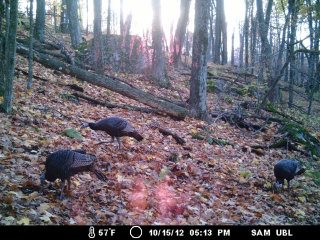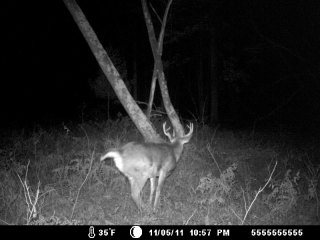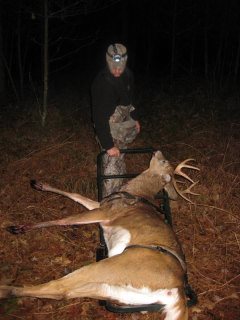WIND, Your Best Bet to Staying Scent-Free
Category: article
Aug 16th, 2013 by OutdoorsFIRST
Modified Aug 16th, 2013 at 12:00 AM
The evening sun made a soft halo over the combine as it penetrated the cloud of husk dust as the neighbor combed his corn field. It was November 6th, 2011, that I found myself situated at the base of a large ridge face with a lowland cedar swamp to my rear. I had an excellent view outward with a great backdrop to keep me hidden from being sky lined. Deer on the ridge above me would have a hard time seeing me with their elevated vantage point; I would be a blur in the poplars bordering the swamp below them and behind me.
The day was clear and the autumn air crisp. Wind was nil to non-existent besides a subtle breeze that would sometimes shake what was left of the leaves and it was in my favor from the start. I chose the bottom of the ridge because I knew the deer I was hunting would be bedded on the spine of the ridge during the day. Their visual vantage point is excellent up there and the rising thermals in the morning give them the opportunity to smell danger from below with the opportunity to disappear over the other side of the ridge if they need to escape.
 |
|
|
|
As the sun began to sink further down to the treeline, squeezing the last of its energy out across the fresh cut corn and highlighting the knee-high remaining stalks with rich golden color. The sky radiated with vibrant oranges and yellows and there I was in my very own Terry Redlin painting.
I leaned into the tree just as a black headed chickadee fluttered on to a branch just a few feet away, pivoted a couple turns and disappeared just as quick as it had shown up. With the fading light came the cooling temperatures and I tucked my chin into the collar of my coat. Surely with the dryness of the day and the evening’s thermal down-flow, my scent would stay at the bottom of the ridge and hopefully carry in the same general direction as the light breeze I had earlier was headed.
Just like that the leaves had gone silent, as did the rest of the woods except for a couple big fox squirrels digging under the leaves on the side of the ridge above me. With the cooler air falling off the ridge and settling over the lowland behind me, I pulled out one of the milkweed seeds I had saved from earlier in the season and let it go. Sure enough it floated down but carried in the same general direction the breeze had been blowing earlier. It never landed, just hovered several feet above the ground, dodging trees and downfalls until I lost sight of it further out than I can shoot.
 |
|
|
|
I glanced at my phone to check the time and figured I had about 30-minutes of hunting time left and that’s when I heard them coming.
I couldn’t see down the ridge all the way to my right, but unmistakably they were cutting a diagonal from the top of the ridge on down and heading in my direction. There wasn’t a question of a doubt a buck was nudging a doe. I could hear her trot ahead and stop, followed by a grunt and extra steps catching up to hers. I had the whole visual playing through my head, but I just couldn’t see them. I reached for my bow, took in a deep breath and waited. Up on the spine of the ridge I saw a harem of does trotting away from where the commotion was coming from, but they were a hundred yards up hill and I focused on what was coming.
First I saw the doe and I began to raise my bow in case her pursuer was big enough to shoot, and then I saw him. Instantly I knew he wasn’t the biggest buck I might see over the next couple days on stand, but all the hard work and thinking involved with my set up made this scenario just as I had envisioned it.
I let the arrow fly and watched it sink into its mark.
It was a combination of trial and error that gave me the safe approach to my treestand as I entered from the downwind side of where I figured the deer I was hunting may have been bedded. It was also the thermal concept of “no wind doesn’t mean no airflow to carry my scent stream” that made my stand site selection pre-meditated to be situated at the bottom of the ridge for the evening sit. I assume the harem of does I saw fleeing down the ridge spine were probably bedded up top with the hot doe the buck I had just shot was nudging.
 |
|
|
C
|
Keep It Simple
While I still keep up a “clean room” loaded with all my hunting garments and a ScentPURGEâ„¢ to eat bad odors, I do so out of habit. If I have the opportunity to keep myself and my clothing as odorless as possible before I enter the deer woods, I will because I personally don’t want to smell myself when I’m out there. Instead I’d rather smell the natural’s scent of the woods and the marsh; it just feels better to me and the clearer my head, the better my focus.
I used to maintain the philosophy that wind didn’t play much of a factor so long as I was completely “scent-free”, but I quickly realized after numerous busts that just because your clothes are scent free doesn’t mean your skin is – you still emit pheromones. Just because I can’t smell myself doesn’t mean I’m not putting out an odor.
Unscented soaps and shampoos don’t remove all dead skin cells that emit odor, nor do they stop you from perspiring, which also emits odor, but I still use them. This practice falls right in line with what I mentioned earlier – if I can’t smell myself, I’m more focused and feel more in touch with the natural smells around me. I tend to purchase the less expensive non-scented soaps as opposed to the heavily advertised brands commonly promoted by hunting shows on television. I have nothing against those brands, I just figure unscented is unscented, and the fact of the matter is that more often than not those highly publicized hunting brands are more expensive.
Cover scents and carbon sprays have been tested, as carbon suits, using bloodhounds. Despite all of the test examples precautions, all of the people hiding were still found relatively quickly. A whitetails nose has nearly 3 million olfactory receptors, which is nearly 1/3 more than dogs with the best noses – what does that tell you? Combine their incredible sense of smell with their innate ability to separate smells and believe it or not, a deer can smell the fox urine you doused yourself with, as well as your human scent all at once. My point – you can’t trick an old whitetail’s sense of smell, you can only avoid it.
Remember deer don’t shop at Macy’s or Boston Store – they don’t know that the scent of colognes or perfumes are related to humans, they just know it isn’t natural and that trips their wire and puts them on alert. When you’re in the woods or in the marsh, you’re in their house. If someone is in your own home, you’d hear any sound that was out of the ordinary. Innately we become conditioned to the smells in our homes, probably enough so that you don’t notice them anymore and are comfortable with them. Now imagine if Sasquatch crept in your home – you’d probably notice an unfamiliar smell and it would alarm your senses. This same concept is shared by conversely when you enter the deer woods.
I wear rubber boots the majority of the time because I do believe they leave less scent on the ground, but I know the deer will still smell where I walked when they cross my path. Branches reach out and touch your clothes, or you move a branch with your hand or glove, ultimately leaving scent behind. Not to mention, the invisible wake of your scent you leave behind as you move. You simply can’t beat science and most definitely cannot fool a deer’s nose.
By this point you might be shaking your head and in total or partial disagreement with everything you’re reading here, but hear me out. I, too, have had deer dead downwind of me and seen them mosey around without going on high alert. I’ve also seen deer walk right over my walk-in trail and not go on high alert. Some deer have stopped and smelled my tracks, others never lowered their head, but I know they know I was there; by their own grace they are putting up with the smell for one reason or another. It’s hard to say why a deer may smell you but not bust out of there. It may have to do with conditioning to some degree depending on the population density surrounding your hunting area. It may also be due to fluctuations in an unsteady directional wind current. Many would be surprised how even when it seems like there is absolutely no wind, thermals will carry a milkweed pod up and down and all around, potentially avoiding a deer’s nose. If you wind up with a deer downwind of you and it doesn’t spook, consider yourself lucky.
Like my initial story that started this article pointed out, even when it’s as calm as could be, natural thermals create air movement at all times of the day and inevitably will carry your scent in the air stream. Milkweed pods are the absolute best visual indicator of the general air flow direction because you can watch those little parachutes travel up and down and around the trees without running into them as they float along. They are, in essence, replicating the flow of the scent you are inevitably emitting.
I admit, I chew gum and drink water when I’m in the stand to keep my breath “fresh”, but I do that so I’m not thirsty and my mouth feels cleaner, not so deer can’t smell my breath. I hang my clothes prior to the hunt and store them in my “clean room” with my ScentPURGEâ„¢ to keep them away from cooking and other odors in the house. I occasionally lug my hunting clothing in a Rubbermaid bin and get dressed in the field if it’s not too cold. I do not, however, contend the simple matter of fact that I only do all of these things out of personal habit, not as a precaution.
Wind is the absolute best contender for beating a deer’s nose, primarily because it is the only contender that stands a winning chance for avoiding scent detection. I’ve heard many times that wind isn’t important so long as you stay “scent-free”. Before I had logged as many hunts as I have to this point in my hunting career, I truly believed that, too. Sometimes the voices behind this statement are made by hunters who have multiple big bucks on their wall (I wasn’t one of them) of which were dead downwind when they put an arrow through them, and that is the backbone of their argument. My argument was empty; I was just repeating what I had seen advertised so many times before.
 |
|
|
|
I salute anyone who can put themselves into bow range of a wise old whitetail buck; there is much to be said for that. But if we set our egos aside for a second and open our minds to a couple of considerations, let’s ask ourselves if those bucks really couldn’t smell us, or if they just put up with it for one undefined reason or another. I already know my answer in a circumstance like that, and that is that there are definitely times I’d rather be lucky than good when I’m in the deer woods. I’ve found myself in the right tree for the wind I was up against, but a sudden shift in wind direction suddenly occurs and it’s not the right time to climb down and back out or relocate.
I, too, have killed deer dead downwind of me in circumstances like this, and I thank my lucky stars for it. Don’t gamble if you don’t have to, it doesn’t make sense.